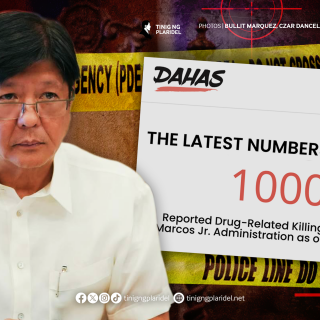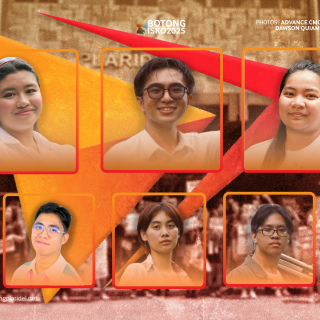Trigger warning: This article contains graphic descriptions and images of death.
Junjun, 9, was on his usual route to school the morning of Oct. 2, sandwiched between his father, Oscar, driving the motorcycle and his mother tucking him from behind.
Little did he know that his trip would be cut short at the intersection of Magsaysay and Roces Ave., with his father’s bloody head sprawled on the concrete after a pick-up truck driver crashed into them.
Four days later, Jane was crossing the street from Kamia Residence Hall, her dorm, towards Palma Hall when a speeding motorcyclist disrupted her path. A torn shirt, a broken tooth and a bout of scratches and bruises forced the third-year student to miss her classes that day.
Since in-person classes started at the University of the Philippines Diliman (UPD) in September, at least 23 road crashes and incidents have been recorded by the UPD Police (UPDP). A total of 47 individuals were involved.
While four-wheeled vehicle drivers stirred most cases, reports reveal that pedestrians and motorcyclists bear the injurious impacts of most road crashes.
Latest data from the Metro Manila Development Authority show that motorcycle drivers absorb the most injuries, both fatal and non-fatal, in recorded road crashes in Metro Manila.
Similarly, the World Health Organization singled out pedestrians, cyclists and motorcyclists as “vulnerable road users” in their 2023 Global Status Report on Road Safety.
Bloody, trauma-filled
Oscar was rushed to the East Avenue Medical Center (EAMC) by the University Health Service (UHS) after the collision but was proclaimed dead on arrival, according to the UPDP.
Meanwhile, Junjun and his mother sustained bruises.
With photos as their lone form of documentation of the incident, the campus police could only assume that the car driver went beyond the speed limit. No CCTVs are mounted along the intersection of Magsaysay and Roces Ave as of press time.
“Siguro ‘yung nangyari medyo mabilis ‘yung takbo ng Hilux kasi kung 30 kilometers per hour (kph) lang takbo niya at least nakapagpreno siya agad,” said Gregorio Aquino Jr., head of UPDP’s Investigation and Follow-Up Section.
The maximum speed limit in UPD is 30 kph as per the parameters set by the Land Transportation and Traffic Code. In some areas like the National Science Complex, the limit is 20 kph.
Oscar’s sister Banzon couldn’t process the demise of her brother who, she said, is known for consistently donning a helmet and knee pads whenever he rides out: “Parang sobrang bilis [ng suspect] e para sumalpok nang gano’n sa kapatid ko.”

The UHS rushes to the crime scene with an ambulance to bring Oscar to EAMC, Oct. 2. The rider’s helmet is seen just above his head while Junjun and his mother stand near their fallen loved one. Photo courtesy of UPDP
Junjun was traumatized, his aunt added, as the 9-year-old saw and touched the blood of his father. “Tawag niya nga doon sa sasakyan, ‘monster truck,’” Banzon said.
The campus police recommended in their case report the construction of speed bumps along “all intersections” in the absence of traffic lights.

A portion of UPDP’s report that shows their recommendation is highlighted in yellow. The identities of individuals involved were redacted by TNP.
Traffic lights and speed bumps are considered “externality-reducing infrastructure” that “reduce travel speed and prevent accident risks, even if there is no congestion.”
Stop signs and speed bumps are currently situated along Magsaysay Ave., but there are none along Roces Ave. towards the infamous intersection. There are also no speed limit signs on both of these thoroughfares.
For Banzon, stationing more enforcers along busy junctures is key to preventing further crashes, considering the thousands of students who traverse the campus every day. A student, unfortunately, was the next one to feel the wrath of an erring motorcyclist.
Jane was crossing a pedestrian lane at Quirino Ave., a road located outside her dorm at around 8 a.m. on Oct. 6 when she was struck by a rider driving a Kawasaki motorcycle.
“Bakit ako umiikot?” was the first thought she had upon the collision. “Then I fell sa ground in a supine position,” Jane recounted.
A passerby aided the 21-year-old who belatedly realized that her tooth had been chipped. She only noticed that her shirt was torn while waiting for campus authorities near the site, and upon arriving at the UHS felt the sting of the impact on her legs.
An interrogation by the UPDP forced the motorcyclist to admit that he was speeding through Quirino Ave., a pedestrian- and motorist-filled thoroughfare on campus as it threads behind Palma Hall, the Kamia and Sampaguita residence halls and successive jeepney stops. The suspect also vowed to shoulder the student’s medical expenses.
Jane was brought back home to Laguna by her family so she could heal. She didn’t have to endure campus traffic and flights of stairs in school buildings the following week because of the reading break.
Her broken tooth has since been filled in. But pain still lingers in Jane’s legs along with another feeling she can’t shake off: “Since lagi akong natawid doon sa pedestrian [lane], minsan natatakot na ako.”
Where’s and who’s of road crashes, incidents
Oscar and Jane’s cases are only two of the 23 documented road crashes and incidents by the UPDP since September, translating to at least one to two cases every week. This is a jump from the previous five-month regular semester when 14 incidents of road crashes and incidents were recorded by the campus police.
Jacinto St. was most notorious for road crashes. A portal along the busy C.P. Garcia Ave. marks the start of this thoroughfare. It is also home to crowded food establishments like the Gyud Food Hub and Mang Larry’s Isawan.
Its node with the University Ave., considered the main entry point of all vehicles to the campus, was the most crash-prone area along Jacinto St.
Towards the end of Jacinto St. lies Magsaysay Ave., another crash-prone road, that serves as a portal for vehicles coming from Katipunan Ave. It is also densely populated by dormers as the Molave, Yakal and Ipil Residence Halls are situated along Magsaysay Ave.
Data further revealed that four-wheeled drivers, who also happen to be non-UP constituents, were mostly embroiled in road crashes and incidents on campus.
The Office of the Vice Chancellor for Community Affairs (OVCCA) issues UP stickers with the goal of “monitoring the entry and exit of vehicles on campus.” This is meant to limit the passage of vehicles through select campus portals, including Jacinto and Magsaysay.
It is currently on hold to “give way to the preparation and release of the 2024 UPD Vehicle Stickers.”
Reality, however, is a far cry from the provisions of Vice Chancellor Roehl Jamon’s memo. All kinds of road users, whether they have official business in UPD or not, can roll through many – if not all – portals with ease.
“For the longest time, the sticker is difficult to implement for the sole reason that UP is a public institution,” he explained in an interview with Tinig ng Plaridel. “When we start implementing very strictly the sticker thing, it opens a whole can of worms of who’s allowed entry or not,” Jamon added.
As it turns out, the vice chancellor’s rationale for continuing the issuance of stickers is somewhat mismatched with the memo he penned. For now, he considers it only as a starting point for the administration’s eventual goal of directing vehicles’ entry and exit.
He plans to “liberalize” the distribution of stickers first and, possibly next semester, “incentivize” sticker-holders rather than limiting the entry of those who refuse to secure one.
“Yung point of issuing stickers is hopefully, eventually, we will get there,” he said.
For him, though, education on traffic rules should be the priority in avoiding road crashes: “Everyone here in the campus should learn how to share the road kasi that’s the only way that we can address this so-called traffic issue.”
Since his installment as an administrator this August, Jamon has instructed the Transportation Management Office (TMO), which is under the OVCCA, to “beef up” their information education campaigns through tarpaulins about road safety.
Engr. Aileen Mappala, the director of TMO, has since complied. With the help of her original office, the National Center for Transportation Studies, the TMO created fliers on road rules provided to freshmen during their orientation. A tarpaulin was also created specifically for UPIS students.

Freshmen received this flier during their orientation program this September. Photo by Guinevere Latoza

This TMO-created poster was posted in UPIS, but Mappala is unsure if it’s still up. Photo by Guinevere Latoza
Education is only part and parcel of managing traffic and transportation. TMO’s mandate includes “planning, design, supervision, traffic management, education, road safety and discipline.”
19 enforcers, 493-ha campus
TMO’s director said that assessing road crashes requires not only looking at the human error and the mechanical vehicle but also at the engineering or design aspect of the scene.
This is why Mappala, who has a background in transport planning and engineering, recommended the installation of a raised intersection at the juncture of Magsaysay and Roces Ave. The OVCCA has already been informed about her recommendation, she said.
As for the proposed speed bumps of the UPDP, she was only made aware of it during her interview with TNP, but agrees that it can also help regulate vehicle speed along the intersection.
Processing of road structures, however, often leads to a bumpy journey from request until procurement.
“Architectural, infrastructural modifications go through a more difficult process,” Jamon said. The concerned office first has to craft a project and budget proposal that have to hurdle the approval of the Office of the Vice Chancellor for Planning and Development and the Office of the Campus Architect.
After which, the Office of the Vice Chancellor for Administration (OVCA) will check if there are available funds before the proposed project can be endorsed to the UPD Chancellor.
This is the norm in most government offices, clarified Jamon: “Offices will be the ones to tell us kung ano yung needs nila … Dahil hindi ko naman hawak ‘yung budget ng UP, the best that I can do is endorse their request to the [OVCA].”
Requesting, which could span months, is only one thing. Acquiring the approved items is another because as a government institution, UP has to go through the procurement process, which can also last for months.
Preparing an annual procurement plan and budget proposals adds weight to Mappala’s work because TMO does not have an administrative officer.
Moreover, TMO only has 19 traffic enforcers managing the vehicular traffic pulsing through the 493-hectare campus. All of them work under a contract-of-service scheme, making Mappala its sole regular employee.
“You could have all the facilities and infrastructures. Pero without enforcement, balewala ‘yung mga rules and regulations,” Mappala said of the importance of having enforcers.
UPD’s traffic enforcers have two eight-hour shifts per day which starts at 6 a.m. They are commonly stationed near the mouth of the Magsaysay portal, the northern arc of the Academic Oval (near UP Law) and Velasquez St. Most crucial is the UP Integrated School (UPIS), said the TMO director.
“Mas maraming tao ang nilalagay [sa UPIS] kasi [may mga] bata e. So magpu-pull out kami from other points and intersections,” Mappala explained. UPIS, the laboratory school of the UP College of Education which is situated along Quirino Ave., near a portal to Katipunan Ave., caters to students from kindergarten to senior high school.
The lack of workers pushes Mappala to tap Special Service Brigade members from the Public Safety and Security Office. They also have one member from the UPDP helping.
Deprived of a fixed budget every year, TMO can only pray for additional enforcers, an administrative officer and the approval of budget requests to bring their vision to life: a UPD where traffic enjoys an efficient flow, rule violators are apprehended and active transport trumps a car-centric culture.
As of Dec. 14, the intersection where Oscar died that morning of Oct. 2 still looks the same. One can rarely see enforcers stationed there, even after the road crash.

The driver that killed Oscar was coming from the far end of Roces Ave., as seen above, before approaching the intersection. The speed bump recommended by the UPDP has yet to be seen.
EDITOR’S NOTE: The names and faces of the victim and survivors are withheld for their privacy.









